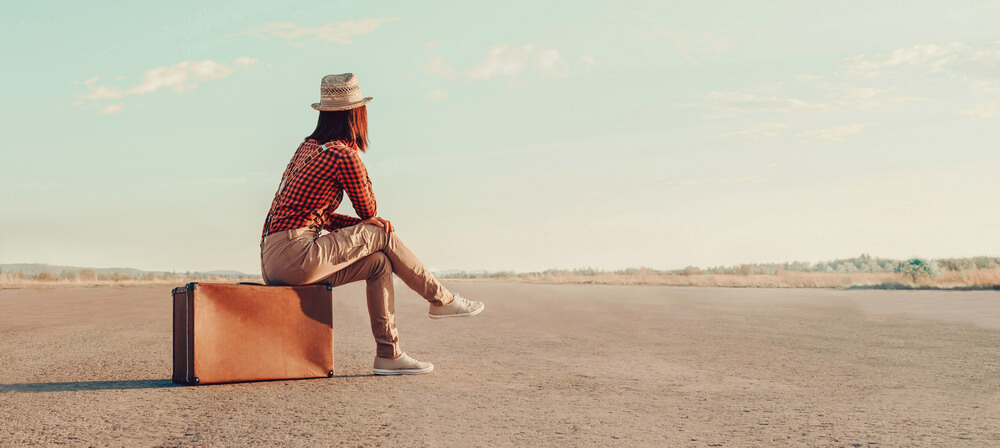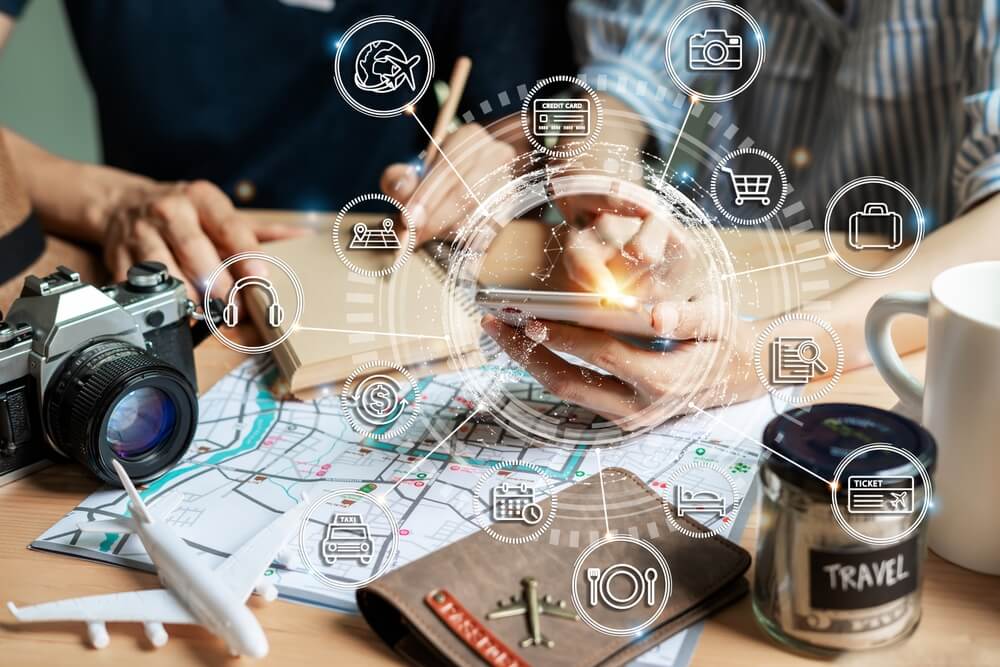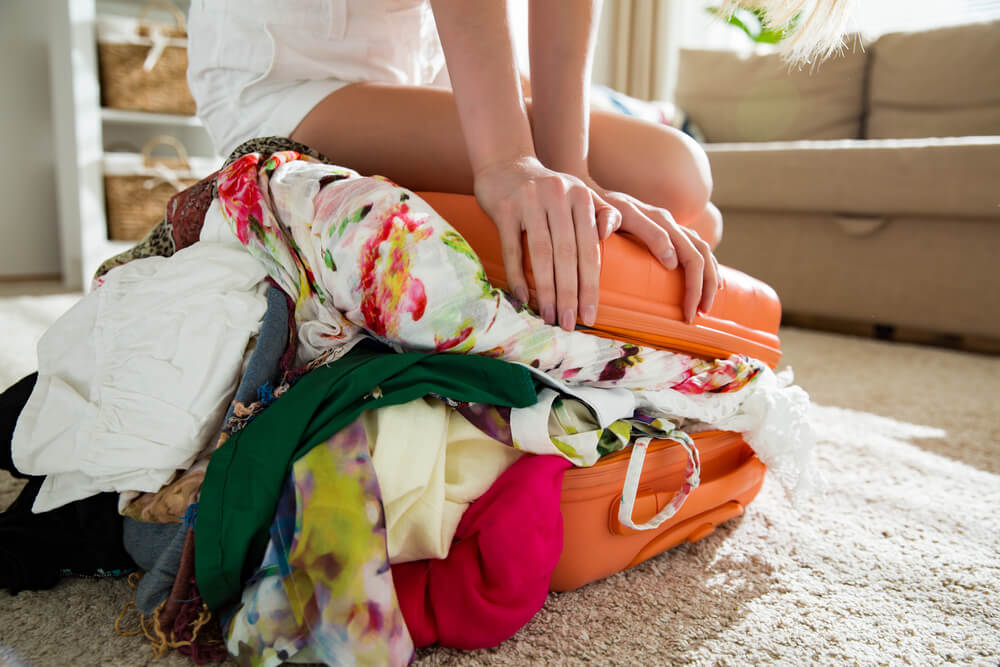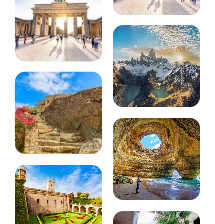The art of packing…

First of all, don’t panic, before you want to pack absolutely everything and are afraid you’ll forget something.
Take a deep breath, relax and remember that there are bound to be supermarkets where you’re going, so it’s no big deal if you’ve forgotten the toothpaste or sun cream!
What you pack doesn’t really depend on the length of your trip. It may seem surprising, but I can tell you from experience that packing for a fortnight, two months or two years is pretty much the same thing.
What you need to take into account are the countries you’ll be travelling through, their geography and climate, and the activities you have in mind.
There are those who like to travel light and leave with a pair of shorts and two T-shirts in their rucksack, and there are the others, who are afraid of running out and want to be prepared for every possibility!
Whether you’re a minimalist or go for the huge wheeled suitcase is up to you, but there are a few things you should bear in mind if you want to be sure you’re travelling with peace of mind.
Here’s our essential checklist to make sure you don’t forget anything when you leave!
Please note that this list is designed to give you ideas and organisational techniques, and that it’s by no means recommended that you pack everything – just take what makes sense for your destination! We agree that you’re not going to take the big feather down jacket to a hotel club in Greece!
Before you leave…
When you’re away from home, it’s important to be prepared for difficult situations, such as having your papers stolen or your bank card hacked. Chances are nothing will happen to you, but if you do fall victim to a scam, you’ll be glad you planned ahead!
- Before you leave, tell your bank! Just so they don’t cut up your credit card thinking there’s been a mistake when they see the charges in Las Vegas!
- Take some cash with you so that you can change money for the first few days if you need to.
- Scan all your important papers and email them to yourself or to someone you trust (passports, identity cards, driving licences, health cards, etc.).
- Write down your useful passwords (codifying them if necessary).
- Manage the procedures for recovering Google and bank passwords by selecting a method other than by telephone! Very important if you can’t get a signal or if your phone is stolen!
- Update your vaccinations and take your vaccination certificate with you.
- Ask your national health insurance office for a European health insurance card (for travel within Europe, of course).
- Have an international driving licence made up at the préfecture (it’s free, but don’t forget that it’s only valid when accompanied by the real driving licence).
- Don’t forget your prescriptions, and make a note of the brand names of any medicines you need to buy abroad.
- Take out insurance, especially if you’re travelling outside Europe.
- Find out about exchange rates, tips and tricks for the country you’re going to. The Internet is full of comprehensive travel blogs, so read them!
So, if you’ve already done all that, you’re well on your way to a worry-free trip. Now let’s look at how to pack well.
At the airport…
If you’re going by plane, there are also a few things to think about to make sure you’re comfortable.
- Pack your hand luggage carefully. I’m not telling you anything new: liquids and sharp objects (as well as drugs, firearms, plants and animals, etc.) are strictly forbidden on board.
- Take mini bottles or travel-size or solid cosmetics with you if you wish to have them in your hand luggage (or if you don’t have hold luggage). Remember, sun cream counts as a liquid!
- Don’t forget to empty your water bottle, so you don’t have to drink a litre of water in one go at customs.
- You should also be aware that you will have to take off your belt, jewellery and sometimes your shoes to get through customs. Remember to dress comfortably, wear little or no jewellery and shoes that are easy to take off and put on.
- Make sure you have headphones, an eye mask if you want to sleep, a neck brace or an inflatable cushion, and compression socks if the altitude is too much for you.
The suitcase…
First and foremost, avoid unpleasant surprises when boarding your flight by checking that you have taken hold baggage, that it has been paid for and validated, and that it weighs the right amount.
On long-haul flights, most airlines accept 23kg, but with the new low-cost fares, baggage is less and less automatically included and may have weight restrictions. If you have a local domestic flight, also check the baggage allowed on that route. If you set off with your 23 kg of luggage and you take a connection with only 12 kg authorised per person, you’ll look clever!
You can find very practical luggage scales to find out the exact weight of your suitcase.
Then look at the practical side. Are you going to go from hotel to hotel in taxis or organised transfers in towns with well-tarmacked pavements, or are you going to find yourself in the middle of nowhere, going to accommodation in the jungle, taking a boat or armoured buses?
The hard-sided, wheeled suitcase can turn into your worst enemy in destinations that are more wild than urban, shall we say. Adapt your equipment to your trip!
So, if you’re travelling to a cold country and you have to pack a heavy jacket that takes up half your bag, remember to either put it on yourself or compress it using the air-reduction bags provided.
So, what should you pack?
Paperwork
Use hidden belts or travel fanny packs to carry cash and important papers.
- Passports / Identity cards
- Driving licence / International licence
- Vaccination booklet / QR code for your Covid vaccination (you never know!)
- Money / credit cards
- Booklet with passwords, addresses for postcards (always a pleasure)
- Call centre number to stop payment on your credit card in the event of theft.
- Insurance certificate and contact number.
Electronics
Don’t forget to find out about power sockets beforehand! Make sure your device supports the voltage of the country where you are going to recharge it! (Your insurance company will not pay for any damage caused by a power surge or misuse of the adapter).
- Telephone (but I can’t imagine you leaving without one!)
- Universal adapter
- Charger and multi-USB connection
- External battery
- Solar charger (if you’re going on an expedition!)
- Headphones or earphones
- Camera/Go Pro or other and SD card
- Flashlight or headlamp
For transport
If you like to sleep soundly on the move, or if you’re going to be taking a lot of local buses, domestic flights or long-haul flights, here are a few essentials.
- Eye mask
- Air cushion
- Compression socks
- Mini fleece blanket or a comfortable jumper, waistcoat or poncho, but the air conditioning can be fatal even in summer!
- Earphones and earplugs
- Books or reading light to save space (remember to load your books before you leave)
- Hydro-alcoholic gel
- Solid deodorant
- Hand cream
- Foldable toothbrush and solid toothpaste tablets (or mini-toothpaste from your dentist)
- Anti-seasickness or travel sickness tablets, or even light sleeping pills for those who have trouble, peppermint essential oil to breathe in when you’re in a bus speeding through the mountains!
- A small code padlock to lock your bag and sleep soundly.
The Toiletry Bag
If you don’t have a travel toilet bag, try to find one that’s well compartmentalised and has a hook so it can be hung anywhere! Very practical in small bathrooms with no space or in unusual accommodation.
Solid cosmetics have been around for a long time, and they’re finally coming into the limelight, so goodbye shower gel that empties into your suitcase, now we’re buying solid! It’s good for the planet, it’s economical and it works just the same!
- So, soaps, shampoos, conditioners, solids!
- Toothbrush with interchangeable heads (and one or two spare heads if you’re going away for a long time) + solid toothpaste
- Washable cotton buds
- Make-up remover (also available in solids)
- Deodorant (also available in solids)
- Sun cream (also available as a solid)
- After-sun, aloe vera, Biafine etc.
- Mosquito repellent (also available as a solid)
- Body cream (also available in solids)
- Pocket mirror, tweezers, nail clippers
- Contraceptives
- Feminine protection
- A little make-up
- Comb or folding brush
- Razor/shaving foam/wax strips/dehair remover/trimmer (if you’re going away for a long time, of course)
- Hair elastics
- Mini microfibre towel
- A piece of Marseille soap for washing clothes
- Avoid hairdryers (and straightening irons), hotels will have them and if not, you’ll survive!
The First Aid Kit
Once again, don’t panic, there will be chemists, hospitals and doctors wherever you go. But it’s true that it’s not always easy to make yourself understood and it’s always better to have a basic kit to hand!
If you’re travelling off the beaten track and into remote areas of the world, then yes, be prepared!
- Basic kit: bandages, sterile gas, mini scissors, plasters, plasters, compresses, etc. You can buy a complete first-aid kit from a chemist.
- Disinfectant and anti-bacterial: water purification pills such as Micropur, saline solution, healing cream, Mercurochrome, etc.
- Paracetamol, ibuprofen, amoxicillin (antibiotic), antispasmodics
- Aspi venom, soothing creams for insect bites or cortisone creams for more severe bites or skin problems.
- Anti-histamines, pills for motion sickness or seasickness
- Medication for digestion and nausea, such as Smecta, Imodium, Gaviscon, etc.
- Ointment for burns, such as Biafine
- Ointment for sore muscles: Tiger Balm, Arnica, Voltaren
- Your medicines and the prescriptions that go with them.
- Your blood group card, carte vitale and mutuelle or European health insurance card if you are travelling in Europe.
- Your vaccination record
Your clothes
Here again, everything is relative. Take what makes sense!
Try to visualise your holiday or your trip! What are you going to do? Are you going to go out every evening or are you going to go hiking every day in the great outdoors?
Whatever the case, here are the basic essentials:
- Underwear and socks (5 to 7 pairs are enough, and you can hand wash them regularly)
- Pyjamas or something to sleep in
- T-shirts and tank tops
- Leggings or sports trousers for walking or for the evening
- Dress trousers, jeans etc.
- Shorts / Skirts / Dresses
- Sweatshirt / Waistcoat or jumper (if you’re taking fragile items with you, you can roll them up in your thick clothes)
- Jacket / Windbreaker / K-way
- Comfortable walking shoes / trainers
- Town shoes / sandals
Sea and beach specials
- Swimwear
- Pareos / beach towel
- Beach bag
- Flip-flops / sandals
- Open-toe walking shoes
- Hat / cap / bob
- Sunglasses
- Sun cream
- Mask and snorkel
- Mosquito net and anti-malaria treatment in high-risk areas
Special ski and mountain
- Thermal underwear / Technical and breathable first skin
- Thin fleece
- Ski socks
- Ski gloves and silk under-gloves
- Around the neck
- Sleeveless jacket
- Warm jacket or ski jacket
- Ski trousers
- Snow boots (lined, waterproof and non-slip)
Special outdoor, trekking, wild camping and bivouac gear
- Hiking shoes
- Comfortable, warm and breathable sportswear
- Nightwear
- Wind and rain jacket
- Light, easy-to-pitch tent
- Sleeping bag suitable for expected temperatures
- Ground sheet or thin, self-inflating mattress
- Compact or inflatable camping pillow
- Headlamp/flashlight
- Swiss Army knife
- Survival blanket
- Mini stove and refill
- Ultra-light compact kitchen kit
- Ecological washing-up soap + sponge and cloth
- Rubbish bag
- Toilet paper and lighter to burn the paper if you don’t have a bin
Accessories
- A water bottle! Indispensable if you don’t want to buy tons of plastic water bottles, and it keeps the water cool all day long! I’d like to take this opportunity to remind you that it takes 100ml of petrol, 80g of coal, 42L of gas and 2 litres of water to make 1 bottle of water…(source: France Nature Environnement).
- Travel size games
- Playing cards / Dice
- Notebook / Pen
- Colouring book / Pencils
How do you fit all this into one suitcase?
Once you’ve got everything you need together, you still have to fit it all into your suitcase! One last time, see if you can do without the extras and take clothes that go with everything!
You can also use travel organisers. They’re really handy to help you see things more clearly. They come in a variety of sizes, so you can compartmentalise your belongings and find them more quickly. Be sure to keep an empty bag for dirty laundry!
Try your hand at folding! Rolling your clothes is a good way of saving space. Others prefer bundle packing, where you stack all your clothes on top of each other and then fold the sleeves and other items towards the centre.
You can also compress the bulkiest garments using vacuum-packed storage bags to save a considerable amount of space.
And finally, make the most of your space! You can roll socks into shoes, stack bras, shells into shells, and so on. Be inventive!
Last but not least, don’t forget to save room for the return journey! You’re bound to bring back souvenirs, buy specialities or fall for a particular item of clothing! Don’t be caught unprepared and pack light!
200 audioguided tours for cities all around the world
Download


